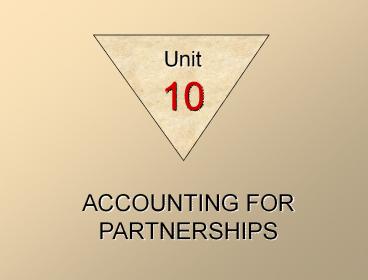Accounting for Partnerships - PowerPoint PPT Presentation
1 / 17
Title: Accounting for Partnerships
1
Unit
10
ACCOUNTING FOR PARTNERSHIPS
2
ADMISSION OF A PARTNER
- The admission of a new partner results in the
legal dissolution of the existing partnership and
the beginning of a new partnership. - To recognize economic effects, it is necessary
only to open a capital account for each new
partner. - A new partner may be admitted either by
- 1. Purchasing the interest of one or more
existing partners, or - 2. Investing assets in the partnership.
3
PROCEDURES IN ADDING PARTNERS
Admission of Partner through
I. Purchase of a Partners Interest
- The admission of a partner by purchase of an
interest in the firm is a personal transaction
between one or more existing partners and the new
partner. The price paid is negotiated and
determined by the individuals involved it may be
equal to or different from the capital equity
acquired. Any money or other consideration
exchanged is the personal property of the
participants and not the property of the
partnership.
4
PROCEDURES IN ADDING PARTNERS
- When a partner is admitted by investment, both
the total net assets and the total partnership
capital change. When the new partners investment
differs from the capital equity acquired, the
difference is considered a bonus either to 1)
the existing (old) partners or 2) the new partner.
5
BONUS TO OLD PARTNERS
- The procedure for determining the new partners
capital credit and the bonus to the old partners
is as follows - 1. Determine the total capital of the new
partnership by adding the new partners
investment to the total capital of the old
partnership. - 2. Determine the new partners capital credit by
multiplying the total capital of the new
partnership by the new partners ownership
interest. - 3. Determine the amount of bonus by subtracting
the new partners capital credit from the new
partners investment. - 4. Allocate the bonus to the old partners on the
basis of their income ratios.
6
BONUS TO NEW PARTNER
- The procedure for determining the new partners
capital credit and the bonus to the new partner
is as follows - 1. Determine the total capital of the new
partnership by adding the new partners
investment to the total capital of the old
partnership. - 2. Determine the new partners capital credit by
multiplying the total capital of the new
partnership by the new partners ownership
interest. - 3. Determine the amount of bonus by subtracting
the new partners investment from the new
partners capital credit. - 4. Allocate the bonus from the old partners on
the basis of their income ratios.
7
ADDING PARTNERS BY INVESTMENT Example
8
ADDING PARTNERS BY INVESTMENT Example cont.
9
WITHDRAWAL OF A PARTNER
- A partner may withdraw from a partnership
voluntarily by selling his or her equity in the
firm or involuntarily by reaching a mandatory
retirement age or by dying. - The withdrawal of a partner may be accomplished
by - 1. payment from remaining partners personal
assets or - 2. payment from partnership assets.
10
PAYMENT FROM PARTNERS PERSONAL ASSETS
- The withdrawal of a partner when payment is made
from partners personal assets is the direct
opposite of admitting a new partner who purchases
a partners interest. - Withdrawal by payment from partners personal
assets is a personal transaction between the
partners.
11
BONUS TO RETIRING PARTNER
- A bonus may be paid to a retiring partner when
- 1. the fair market value of partnership assets is
greater than their book value, - 2. there is unrecorded goodwill resulting from
the partnerships superior earnings record, or - 3. the remaining partners are anxious to remove
the partner from the firm.
12
BONUS TO RETIRING PARTNER
The bonus is deducted from the remaining
partners capital balances on the basis of
their income ratios at the time of the
withdrawal. The procedure for determining the
bonus to the retiring partner and the allocation
of the bonus to the remaining partners
is 1. Determine the amount of the bonus by
subtracting the retiring partners capital
balance from the cash paid by the partnership.
2. Allocate the bonus to the remaining partners
on the basis of their income ratios.
13
BONUS TO REMAINING PARTNERS
- The retiring partner may pay a bonus to the
remaining partners when - 1. recorded assets are overvalued,
- 2. the partnership has a poor earnings
record, or - 3. the partner is anxious to leave the
partnership.
14
BONUS TO REMAINING PARTNERS
The bonus is added to the remaining
partners capital balances on the basis of their
income ratios at the time of the withdrawal.
The procedure for determining the bonus to the
remaining partners is 1. Determine the amount
of the bonus by subtracting the retiring
partners capital balance from the cash paid
by the partnership. 2. Allocate the bonus to
the remaining partners on the basis of their
income ratios.
15
WITHDRAWAL OF A PARTNER Example
16
LIQUIDATION OF A PARTNERSHIP
- The liquidation of a partnership terminates the
business. - To liquidate a partnership, follow these steps
- 1. Sell noncash assets for cash and recognize
any gain or loss on realization. - 2. Allocate any gain or loss on realization to
the partners based on their income ratios. - 3. Pay partnership liabilities in cash.
- 4. Distribute remaining cash to partners based
on their capital balances.
17
LIQUIDATION OF PARTNERSHIP
- No capital deficiency
- Capital deficiency
- Partner with deficiency pays partnership
- Partners with credit capital balances absorb
deficiency in income sharing proportion































